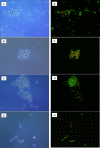Differential involvement of the five RNA helicases in adaptation of Bacillus cereus ATCC 14579 to low growth temperatures
- PMID: 20709848
- PMCID: PMC2950441
- DOI: 10.1128/AEM.00782-10
Differential involvement of the five RNA helicases in adaptation of Bacillus cereus ATCC 14579 to low growth temperatures
Abstract
Bacillus cereus ATCC 14579 possesses five RNA helicase-encoding genes overexpressed under cold growth conditions. Out of the five corresponding mutants, only the ΔcshA, ΔcshB, and ΔcshC strains were cold sensitive. Growth of the ΔcshA strain was also reduced at 30°C but not at 37°C. The cold phenotype was restored with the cshA gene for the ΔcshA strain and partially for the ΔcshB strain but not for the ΔcshC strain, suggesting different functions at low temperature.
Figures




Similar articles
-
Role of the five RNA helicases in the adaptive response of Bacillus cereus ATCC 14579 cells to temperature, pH, and oxidative stresses.Appl Environ Microbiol. 2011 Aug 15;77(16):5604-9. doi: 10.1128/AEM.02974-10. Epub 2011 Jun 24. Appl Environ Microbiol. 2011. PMID: 21705526 Free PMC article.
-
Bacillus cereus cshA Is Expressed during the Lag Phase of Growth and Serves as a Potential Marker of Early Adaptation to Low Temperature and pH.Appl Environ Microbiol. 2019 Jul 1;85(14):e00486-19. doi: 10.1128/AEM.00486-19. Print 2019 Jul 15. Appl Environ Microbiol. 2019. PMID: 31076436 Free PMC article.
-
Insertional mutagenesis reveals genes involved in Bacillus cereus ATCC 14579 growth at low temperature.FEMS Microbiol Lett. 2010 May;306(2):177-83. doi: 10.1111/j.1574-6968.2010.01953.x. Epub 2010 Mar 12. FEMS Microbiol Lett. 2010. PMID: 20370835
-
Identification of Bacillus cereus genes specifically expressed during growth at low temperatures.Appl Environ Microbiol. 2010 Apr;76(8):2562-73. doi: 10.1128/AEM.02348-09. Epub 2010 Feb 26. Appl Environ Microbiol. 2010. PMID: 20190083 Free PMC article.
-
The CasKR two-component system is required for the growth of mesophilic and psychrotolerant Bacillus cereus strains at low temperatures.Appl Environ Microbiol. 2014 Apr;80(8):2493-503. doi: 10.1128/AEM.00090-14. Epub 2014 Feb 7. Appl Environ Microbiol. 2014. PMID: 24509924 Free PMC article.
Cited by
-
RNA helicases: diverse roles in prokaryotic response to abiotic stress.RNA Biol. 2013 Jan;10(1):96-110. doi: 10.4161/rna.22638. Epub 2012 Oct 23. RNA Biol. 2013. PMID: 23093803 Free PMC article. Review.
-
Omics profiles used to evaluate the gene expression of Exiguobacterium antarcticum B7 during cold adaptation.BMC Genomics. 2014 Nov 18;15(1):986. doi: 10.1186/1471-2164-15-986. BMC Genomics. 2014. PMID: 25407400 Free PMC article.
-
DExD-box RNA-helicases in Listeria monocytogenes are important for growth, ribosomal maturation, rRNA processing and virulence factor expression.RNA Biol. 2014;11(11):1457-66. doi: 10.1080/15476286.2014.996099. RNA Biol. 2014. PMID: 25590644 Free PMC article.
-
Cyanobacterial RNA Helicase CrhR Localizes to the Thylakoid Membrane Region and Cosediments with Degradosome and Polysome Complexes in Synechocystis sp. Strain PCC 6803.J Bacteriol. 2016 Jul 13;198(15):2089-99. doi: 10.1128/JB.00267-16. Print 2016 Aug 1. J Bacteriol. 2016. PMID: 27215789 Free PMC article.
-
Short-Chain and Unsaturated Fatty Acids Increase Sequentially From the Lag Phase During Cold Growth of Bacillus cereus.Front Microbiol. 2021 Jul 22;12:694757. doi: 10.3389/fmicb.2021.694757. eCollection 2021. Front Microbiol. 2021. PMID: 34367095 Free PMC article.
References
-
- Ando, Y., and K. Nakamura. 2006. Bacillus subtilis DEAD protein YdbR possesses ATPase, RNA binding, and RNA unwinding activities. Biosci. Biotechnol. Biochem. 70:1606-1615. - PubMed
-
- Arantes, O., and D. Lereclus. 1991. Construction of cloning vectors for Bacillus thuringiensis. Gene 108:115-119. - PubMed
-
- Arnesen, L. P. S., A. Fagerlund, and P. E. Granum. 2008. From soil to gut: Bacillus cereus and its food poisoning toxins. FEMS Microbiol. Rev. 32:579-606. - PubMed
-
- Bleichert, F., and S. J. Baserga. 2007. The long unwinding road of RNA helicases. Mol. Cell 27:339-352. - PubMed
Publication types
MeSH terms
Substances
LinkOut - more resources
Full Text Sources
Molecular Biology Databases

